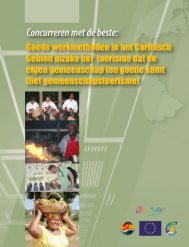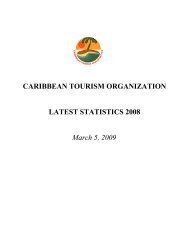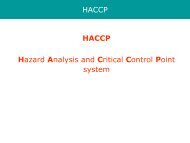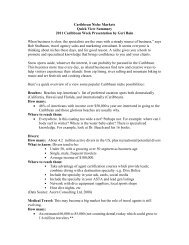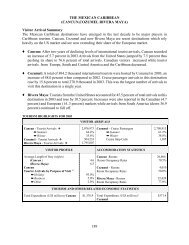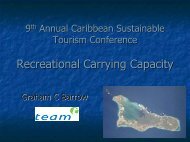Disaster Risk Management Strategy and Plan of Action - Caribbean ...
Disaster Risk Management Strategy and Plan of Action - Caribbean ...
Disaster Risk Management Strategy and Plan of Action - Caribbean ...
Create successful ePaper yourself
Turn your PDF publications into a flip-book with our unique Google optimized e-Paper software.
Regional <strong>Disaster</strong> <strong>Risk</strong> <strong>Management</strong> <strong>Strategy</strong> for the Tourism Sector in the <strong>Caribbean</strong> – Final<br />
<strong>Disaster</strong> response is predominantly focused on immediate <strong>and</strong> short-term needs <strong>and</strong> is sometimes called “disaster relief”. The<br />
division between this response stage <strong>and</strong> the subsequent recovery stage is not clear-cut. Some response actions, such as the supply<br />
<strong>of</strong> temporary housing <strong>and</strong> water supplies, may extend well into the recovery stage. (UNISDR 2009)<br />
The response phase includes the mobilization <strong>of</strong> the necessary emergency services <strong>and</strong> first responders in<br />
the disaster area. This is likely to include a first wave <strong>of</strong> core emergency <strong>and</strong> medical services, such as firefighters,<br />
police <strong>and</strong> ambulance crews. They may be supported by a number <strong>of</strong> secondary emergency<br />
services, such as specialist rescue teams. The focus <strong>of</strong> the response phase is to save lives <strong>and</strong> provide<br />
assistance to victims. A well rehearsed emergency/disaster plan developed as part <strong>of</strong> the preparedness<br />
phase enables efficient coordination <strong>of</strong> rescue. Where required, search <strong>and</strong> rescue efforts commence at an<br />
early stage. Depending on injuries sustained by the victims, outside temperature, <strong>and</strong> victims’ access to air<br />
<strong>and</strong> water, the vast majority <strong>of</strong> those affected by a disaster will die within 72 hours after impact 37 . Speed <strong>of</strong><br />
the initial rescue efforts is therefore vital.<br />
Depending on the nature <strong>of</strong> the event, there may numerous people left homeless requiring shelter <strong>and</strong><br />
assistance. Tourism accommodation facilities located in the affected community – if left serviceable – may<br />
play a critical role in the community response effort <strong>and</strong> as such are a resource. However, their operation<br />
capability may be dependent on the restoration <strong>of</strong> essential services.<br />
3.4.1.1 An Industry on Hold<br />
Tourism activity in the normal sense ceases to exist during the response phase. Tourists caught by an<br />
event will either be at or converge on their accommodation facilities. The tourism accommodation<br />
facilities face the challenge <strong>of</strong> providing the best possible service to their str<strong>and</strong>ed guests, with possibly<br />
reduced resources: structures that may have been more or less damaged; reduced personnel availability;<br />
essential services potentially interrupted; <strong>and</strong>, a disrupted supply system. The challenge could be even<br />
further exacerbated if the facility is deemed essential to provide temporary shelter to other victims.<br />
3.4.1.2 Perception is Reality<br />
The sustainability <strong>of</strong> a tourism establishment is linked to customer satisfaction <strong>and</strong> reputation at source<br />
markets. In area tourists <strong>and</strong> the media will be the vectors conveying the information to the source<br />
markets. Communications during the response phase are essential to reassure not only the affected<br />
population but also source markets. A response perceived as chaotic or even disorganized can have a longterm<br />
impact on the future <strong>of</strong> the industry in the affected country – <strong>and</strong> in the case <strong>of</strong> the <strong>Caribbean</strong>, the<br />
region can also be affected. Communicating to the general population affected by the event is, <strong>of</strong> course,<br />
essential during the response; it is an operational necessity. However, communications targeting the<br />
external audiences are also essential <strong>and</strong> these may take a different form <strong>and</strong> require different skills.<br />
Countries in the <strong>Caribbean</strong> have recognized this reality <strong>and</strong> have instituted a novel approach to manage<br />
communications relying on <strong>of</strong>f-shore resources 38 .<br />
How the response is perceived by tourists at the tourism establishment level is dependent on the response<br />
is conducted in the community where the venue is located. In a sense, notwithst<strong>and</strong>ing the level <strong>of</strong><br />
preparedness <strong>and</strong> efficient execution <strong>of</strong> its emergency response plan, a tourism establishment is hostage to<br />
what happens in its community.<br />
37 Walker, Peter (1991). International Search <strong>and</strong> Rescue Teams, A League Discussion Paper. Geneva.<br />
38 Crisis Communications Manual for the Isl<strong>and</strong>s <strong>of</strong> the Bahamas, 2006.<br />
27





